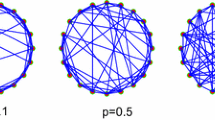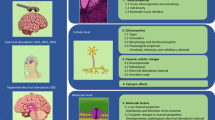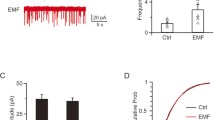Abstract
Purpose
External electric fields can regulate the neural network and change the excitability of the in-vivo cerebral cortex. Here, to prove the effect of alternating electric fields on the synaptic plasticity of ex-vivo tissues, the regular changes in the synaptic structure under alternating electric fields were studied.
Methods
This study applied alternating electric fields with a peak voltage of 20 V and frequencies of 5, 20, 50, and 80 Hz to the porcine cerebral cortex. Relying on transmission electron microscopy (TEM), the ultrastructure of synapses was observed, and the curvature radius of post-synaptic density (PSD) and the synaptic gap distance was quantified.
Results
The results indicated that under alternating electric fields, the average synaptic curvature of the PSD decreased by 30–59% with increasing frequency, and the average synaptic gap distance became narrower.
Conclusion
In ex-vivo brain tissue, synaptic plasticity can be regulated by alternating electric fields of different frequencies. This study can provide reference data for the storage and regulation of ex-vivo organs, as well as comparable data for in-vivo studies.




Similar content being viewed by others
References
Reznik RI, Barreto E, et al. Effects of polarization induced by non-weak electric fields on the excitability of elongated neurons with active dendrites. J Comput Neurosci. 2016;40(1):27–50. https://doi.org/10.1007/s10827-015-0582-4.
Wang H, Chen Y. Spatiotemporal activities of neural network exposed to external electric fields. Nonlinear Dynam. 2016;85(2):881–91. https://doi.org/10.1007/s11071-016-2730-4.
Vrselja Z, Daniele SG, et al. Restoration of brain circulation and cellular functions hours post-mortem. Nature. 2019;568(7752):336–43. https://doi.org/10.1038/s41586-019-1099-1.
Zhang C, Zhao H. The effects of electric fields on the mechanical properties and microstructure of ex vivo porcine brain tissues. Soft Matter. 2022;18(7):1498–509. https://doi.org/10.1039/d1sm01401c.
Rahman A, Reato D, et al. Cellular effects of acute direct current stimulation: somatic and synaptic terminal effects. J Physiol-London. 2013;591(10):2563–78. https://doi.org/10.1113/jphysiol.2012.247171.
Lafon B, Rahman A, et al. Direct-current stimulation-alters neuronal Input/Output function. Brain Stimul. 2017;10(1):36–45. https://doi.org/10.1016/j.brs.2016.08.014.
Matsumoto H, Ugawa Y. Adverse events of tDCS and tACS: a review. Clin Neurophys Pract. 2017. https://doi.org/10.1016/j.cnp.2016.12.003. 219 – 25.
Guerra A, Suppa A, et al. LTD-like plasticity of the human primary motor cortex can be reversed by gamma-tACS. Brain Stimul. 2019;12(6):1490–9. https://doi.org/10.1016/j.brs.2019.06.029.
Zhang C, Li Y, et al. Effects of different types of Electric Fields on Mechanical Properties and microstructure of Ex vivo Porcine Brain Tissues. ACS Biomater Sci Eng. 2022;8(12):5349–60. https://doi.org/10.1021/acsbiomaterials.2c00456.
Sauleau P, Lapouble E, et al. The pig model in brain imaging and neurosurgery. Animal. 2009;3(8):1138–51. https://doi.org/10.1017/s1751731109004649.
Holm IE, Alstrup AKO, et al. Genetically modified pig models for neurodegenerative disorders. J Pathol. 2016;238(2):267–87. https://doi.org/10.1002/path.4654.
Eaton SL, Wishart TM. Bridging the gap: large animal models in neurodegenerative research. Mamm Genome. 2017;28(7–8). https://doi.org/10.1007/s00335-017-9687-6. 324 – 37.
Zhang C, Liu CY, et al. Mechanical properties of brain tissue based on microstructure. J Mech Behav Biomed. 2022;126:104924. https://doi.org/10.1016/j.jmbbm.2021.104924.
Klemann C, Roubos EW. The Gray Area between Synapse structure and Function-Gray’s synapse types I and II revisited. Synapse. 2011;65(11):1222–30. https://doi.org/10.1002/syn.20962.
Santuy A, Rodriguez JR, et al. Study of the size and shape of Synapses in the Juvenile Rat Somatosensory cortex with 3D Electron Microscopy. Eneuro. 2018;5(1):2017. https://doi.org/10.1523/eneuro.0377-17.2017.
Alekseichuk I, Falchier AY, et al. Electric field dynamics in the brain during multi-electrode transcranial electric stimulation. Nat Commun. 2019;10(1):2573. https://doi.org/10.1038/s41467-019-10581-7.
Luo Y, Xu NG et al. Electroacupuncture effect on synaptic ultrastructure in focal cerebral ischemia marginal zone of the rat. Neural Regen Res. 2010; 5(8): 618 – 22. https://doi.org/10.3969/j.issn.1673-5374.2010.08.009.
Marrs GS, Green SH, et al. Rapid formation and remodeling of postsynaptic densities in developing dendrites. Nat Neurosci. 2001;4(10):1006–13. https://doi.org/10.1038/nn717.
Puthenveedu MA, Yudowski GA, et al. Endocytosis of neurotransmitter receptors: location matters. Cell. 2007;130(6):988–9. https://doi.org/10.1016/j.cell.2007.09.006.
Medvedev NI, Popov VI, et al. Alterations in synaptic curvature in the dentate gyrus following induction of long-term potentiation, long-term depression, and treatment with the N-methyl-d-aspartate receptor antagonist CPP. Neuroscience. 2010;171(2):390–7. https://doi.org/10.1016/j.neuroscience.2010.09.014.
Rodriguez-Diaz R, Dando R, et al. Alpha cells secrete acetylcholine as a non-neuronal paracrine signal priming beta cell function in humans. Nat Med. 2011;17(7):888–92. https://doi.org/10.1038/nm.2371.
Wischnewski M, Engelhardt M, et al. NMDA receptor-mediated motor cortex plasticity after 20 hz transcranial Alternating Current Stimulation. Cereb Cortex. 2019;29(7):2924–31. https://doi.org/10.1093/cercor/bhy160.
Berger A, Pixa NH, et al. Brain oscillatory and hemodynamic activity in a Bimanual Coordination Task following transcranial Alternating Current Stimulation (tACS): a combined EEG-fNIRS study. Front Behav Neurosci. 2018;12:00067. https://doi.org/10.3389/fnbeh.2018.00067.
Alekseichuk I, Pabel SC, et al. Intrahemispheric theta rhythm desynchronization impairs working memory. Restor Neurol and Neuros. 2017;35(2):147–58. https://doi.org/10.3233/rnn-160714.
Grossman N, Bono D, et al. Noninvasive Deep Brain Stimulation via temporally Interfering Electric Fields. Cell. 2017;169(6):1029–41. https://doi.org/10.1016/j.cell.2017.05.024.
Wu L, Liu T, et al. Improving the Effect of Transcranial Alternating Current Stimulation (tACS): a systematic review. Front Hum Neurosci. 2021;15:652393. https://doi.org/10.3389/fnhum.2021.652393.
Acknowledgements
This study was funded by the National Science Fund for Distinguished Young Scholars (51925504), the Foundation for Innovative Research Groups of the National Natural Science Foundation of China (52021003), and the National Major Scientific Research Instrument Development Project (52227810). Simultaneously, we sincerely thank Minyue Zeng from the University of British Columbia for her insight into biochemistry and molecular biology to analyze the partial mechanism of changes regarding the brain microstructure under electric fields.
Author information
Authors and Affiliations
Corresponding author
Additional information
Publisher’s Note
Springer Nature remains neutral with regard to jurisdictional claims in published maps and institutional affiliations.
Rights and permissions
Springer Nature or its licensor (e.g. a society or other partner) holds exclusive rights to this article under a publishing agreement with the author(s) or other rightsholder(s); author self-archiving of the accepted manuscript version of this article is solely governed by the terms of such publishing agreement and applicable law.
About this article
Cite this article
Zhang, C., Li, Y., Yang, L. et al. Regulation of local alternating electric fields on synaptic plasticity in brain tissue. Biomed. Eng. Lett. 13, 391–396 (2023). https://doi.org/10.1007/s13534-023-00287-7
Received:
Revised:
Accepted:
Published:
Issue Date:
DOI: https://doi.org/10.1007/s13534-023-00287-7




